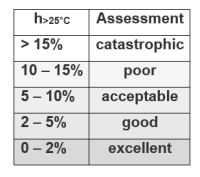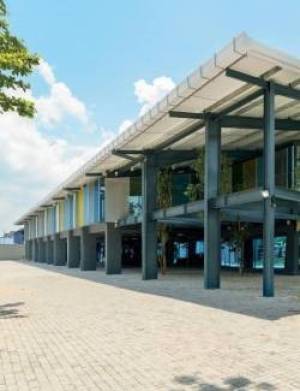Table of Contents
Summer comfort
Welcome to Passipedia's landing page on the topic of summer comfort in Passive House buildings, with an introduction to this topic and links to further Passipedia articles and literature.
A high level of comfort throughout the year forms the basis of the Passive House concept. In warm seasons, in summer, this means maintaining pleasantly cool temperatures in the building. Depending on the location (climate and local surroundings), the type of building and its utilisation, this high level of comfort can be achieved with or without active cooling.

Important: Due to global warming, the topic of protection against overheating is becoming increasingly important, especially since high indoor temperatures are not only a question of comfort, but can also be highly detrimental to health. Due to rising external temperatures, active cooling is increasingly becoming necessary in order to achieve adequate summer comfort also in climates and locations where this it was historically not needed (e.g. in Central Europe). In energy-efficient buildings, this can be realised in a climate-friendly way with very low energy consumption and should be taken into account by planners and building owners as part of the planning process in a future-oriented way. More on this in the articles linked below.
The perception and measurement of thermal comfort in summer is quite complex. Ultimately however, the operative temperature is the decisive benchmark also for assessing thermal comfort in summer; in addition, humidity and air velocity play an important role. In buildings without active cooling, it is usually accepted that temperatures may be slightly above the comfortable range at times. The frequency of overheating i.e. the proportion of hours of the year that are above a certain limit, was introduced as a measure of summer comfort in passively cooled buildings. In a Passive House building and in the PHPP, the frequency of overheating events always refers to a temperature limit of 25°C. A value of 10% is considered as still acceptable, but building design should aim for less than 5%. The frequency of overheating is calculated for the entire building during the desin process using the Passive House Planning Package (PHPP).Further reading: A Simplified Method for Determining Thermal Comfort in Summer for Buildings Without Active Cooling
For buildings with active cooling, the summer comfort level of max. 25°C should be achieved with the lowest possible energy demand. This can also be easily calculated using the Passive House Planning Package (PHPP) during the planning process. The limit value for the useful energy demand for active cooling in a Passive House building is a maximum of 15 kWh/(m²a) in the climate of Central Europe.
Design principles for a high level of summer comfort

Optimising the building design to suit local climate conditions and building use has a fundamental impact on the level of thermal comfort achieved in summer and the energy required for active cooling. It also determines how robust and resilient the building is against the risk of overheating during hot spells, and generally rising temperatures. PHPP and designPH are useful planning tools for this optimisation process.
A temperature increase in a building is ultimately caused by net heat gains. The very first principle for building optimisation and building use through passive cooling measures is therefore to reduce all potential heat sources, e.g. solar gains and internal heat sources. If the temperature rises above the comfortable level, the only effective way to passively dissipate the excess heat is through ventilation at times when the outside temperature is sufficiently low. Click here for a more detailed article on the interrelationships and recommendations for passive cooling as a basis for planning a high level of thermal comfort in summer - relevant for buildings with and without active cooling.
To support planners in developing a robust summer strategy which will ensure thermal comfort throughout the year, the Summer Comfort Guidelines were published within the framework of the EU project outPHit.
The Passipedia article The Passive House in summer uses the example of the first Passive House terraced house in Darmstadt Kranichstein to examine the influence of various structural parameters on summer comfort. The study clearly illustrate the respective effects of the most important influencing factors: ventilation, glazing, building orientation, shading, internal heat gains, thermal mass and thermal insulation.
Further reading:
- iPHA Webinar: Summer comfort with passive measures
- The Protocol Volumes of the Research Group for Cost-effective Passive Houses with a focus on summer comfort and cooling contain valuable basic knowledge, specific planning recommendations and practical experience on the subject.
See further literature below "See also".
Risk analysis: Weather and user influence
The boundary conditions that are used for the calculations during the design phase may differ from those of the actual building one it is in use, e.g. the actual weather of that particular day or year and the user's interaction witht he building. A risk analysis by means of stress testing a design is essential for a robust summer comfort strategy. It provides valuable feedback and a better understanding of the risk factors for overheating and can thus lead to more robust and resilient designs. Stress testing is integrated into the planning tool PHPP version 10 onwards: it shows the calculated frequency of overheating for various scenarios during the planning process.
Further reading: Risk analysis: robust planning for a high level of summer comfort
Factsheet: Robust planning for a high level of summer comfort
The behaviour of residents or users can have a strong influence on the temperatures inside the building, especially with regard to the use of shading elements and ventilation (especially at night, when it is cooler outside than inside the building). Users are not always sufficiently aware of the interrelationships or external circumstances may prevent them from using the full potential of shaing or night ventilation. In order to prevent misunderstandings, it can be helpful to document the passive cooling strategy planned for a specific building and make this available to the users. A template for a user manual was created as part of the EU project outPHit, which explains basic relationships of passive cooling and can be supplemented with specific recommendations for the building.
Summer comfort and climate change
Ongoing global warming is leading to a changing climate worldwide. This affects all buildings, regardless of their efficiency level. Buildings built today will likely be exposed and used in warmer conditions than what we are familiar with today. For future-oriented planning, it is imperative to take the impact of warming climate conditons on summer comfort into consideration. The risk of higher overheating frequencies will increase by the middle of the century and active cooling will probably become necessary in many places where this is not currently the case. Planners and building owners are well advised to take this into account in their design decisions, i.e. to assume warmer summer conditions and implement active cooling form the outset, or at least make plans for simple cooling retrofit measures.
Further reading: On the impact of a warming climate on the energy demand for cooling and summer comfort
Factsheet: influence of global warming on buildings
Tool: Summer temperature tool to adjust PHPP climate data (for PHPP version9)

Passivhaus Datenbank (ID 6030)
Active cooling
Should active cooling be avoided?
Note: A more detailed considerations on this topic and practical experiences gained from the first Passive House building in Darmstadt Kranichstein are also documented here (in German)Practical experience from the first passive house in Darmstadt Kranichstein
If a building (or individual rooms) cannot be kept cool realibly using only passive cooling measures, there is always the option of active cooling. The energy demand and cooling loads in a Passive House building or an existing building renovated to the EnerPHit standard are so low due to the high level of energy efficiency that active cooling can be implemented in a technically simple and climate-friendly way. For a detached house, a single split system air conditioning unit is usually sufficient (an extremely cost-effective solution that can also be used for heating). The months in which active cooling is required in Europe generally coincide well with the availability of renewable solar energy. This means that in almost all cases, the additional energy demand can be met easily and efficiently using sustainable resources, as demonstrated by the PER assessment method. Due to the further expansion of photovoltaics, which is necessary in any case, in just a few years' time there will even be surplus electricity in the power grid in Germany, especially during hot periods.
In warm and hot climates, active cooling for a good level of thermal comfort is out of the question 1) There are already numerous Passive House projects that use efficient solutions in warm and hot climate regions. You can find more information about Passive House buildings in different climate zones.
Further reading: PHPP: Active cooling algorithms
Summer comfort in non-residential buildings
Summer comfort in non-residential buildings has been a central topic for several volumes of the Research Group for Cost-effective Passive Houses. You can find the original publications in German here:
- Protocol No. 57: Building concepts for hot summers–Focus on non-residential buildings (in German)
- Protocol No. 41:Cooling in non-residential Passive House buildings (in German)
Selected articles on the topic of summer comfort in non-residential buildings, including selected articles from the above-mentioned Protocol Volumes can be found here:
See also
iPHA Webinar Summer comfort with passive measures
iPHA affiliate literature: Summer comfort and cooling
iPHA blog: How do Passive House buildings stay comfortable in summer?
Passive House buildings in different climates
Relevant volumes of Resarch Group for Cost-Effective Passive Houses:
- Protocol Volume No. 15: Passive House summer comfort (German, available as printed publication)
Selected translated articles available on Passipedia here - Protocol Volume No. 22: Ventilation strategies for the summer (German, available as printed publication)
- Protocol Volume No. 31: Energy efficient cooling(German, available as printed publication)
- Protocol Volume No. 37:Optimisation strategies for window constructions and solar aperture (German, available as printed publication)
- Protocol Volume No. 41: Cooling in non-residential Passive House buildings (German, available as printed publication)
Selected translated articles available on Passipedia here - Protocol Volume No. 53: Summer comfort – affordable and energy-efficient (German, available as printed publication)
- Protocol Volume No. 57: Building concepts for hot summers – Focus on non-residential buildings (German, available online as a pdf for download)
Selected translated articles available on Passipedia here

